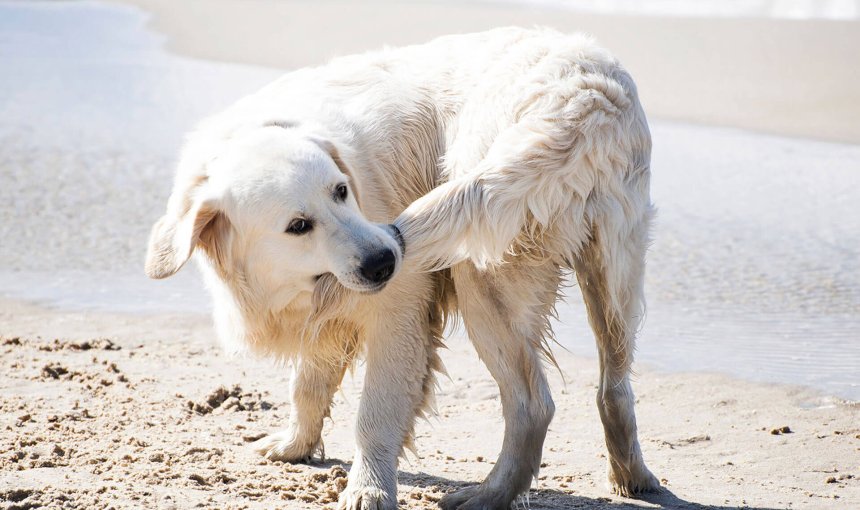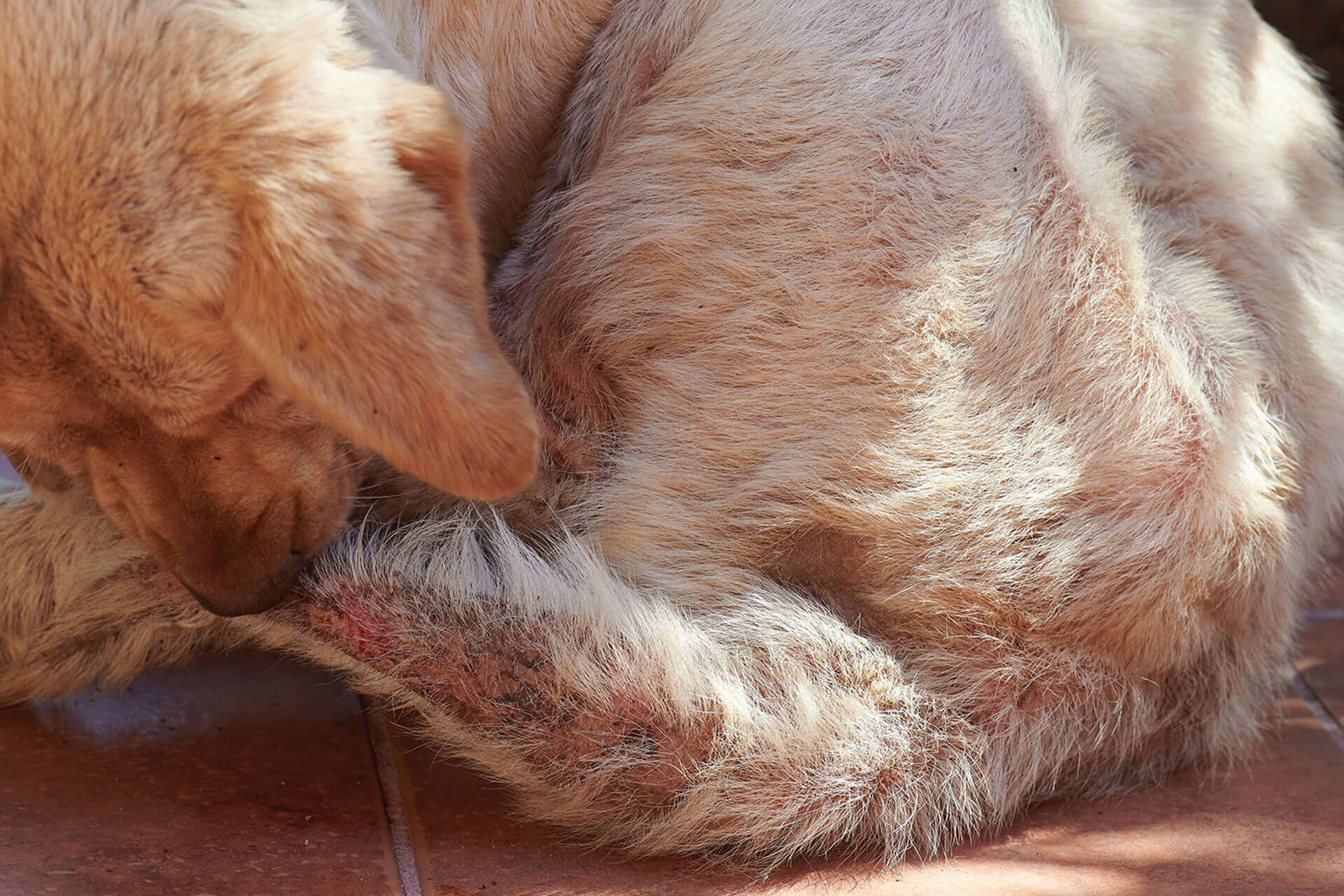Happy Tail Syndrome In Dogs: Symptoms And Treatments
Tail wagging isn’t always a good thing if it leads to injury. Learn how to prevent and treat happy tail syndrome in this post.

Who doesn’t love being greeted by an excited pup with a wiggling bottom and exuberantly wagging tail? Joyous moments like this make dog parenting so rewarding. But too much tail wagging can lead to a problem called happy tail syndrome. Despite its cheerful name, happy tail syndrome can be frustrating to treat. Learn how to identify and treat happy tail syndrome in this post. And while you’re here, learn the other signs of illness in dogs.

Always know your buddy is healthy & safe
Read moreWhat is happy tail syndrome?
Dogs naturally wag their tails to communicate. A wagging tail often means the dog is excited or anticipating something good – like maybe that treat in your pocket will soon be in their mouth!
But too much tail wagging can result in chronic injuries and require veterinary care for happy tail syndrome.
Happy tail syndrome results when a dog repeatedly wags its tail vigorously and makes contact with hard objects like walls, door frames, or furniture. For example, when the dog’s tail strikes a table leg over and over, the skin can break. If this happens every day or multiple times a day, the tiny cut breaks open again and again, gets larger, and never has a chance to heal. The dog’s excitement, which leads to excessive tail wagging, overrides any pain they feel when the tail strikes an object.
Over time, complications can arise and result in happy tail syndrome. In some cases, the damage can include broken vertebrae in the tail, bleeding ulcers, infected sores, or even amputation of the tail.
Symptoms of happy tail syndrome in dogs
Dogs with happy tail syndrome may behave otherwise normally, but pet parents might notice the following symptoms:
- Bleeding from the tail
- Bald spots or hair loss on the tail
- Raw, cracked spots on the tail
- Biting, chewing or licking the tail
Read more: Dog Shedding 101: Why Is My Dog Losing Hair?

What dog breeds are the most prone to happy tail syndrome?
Large, excitable short-haired dogs with muscular or whip-like tails are more likely to experience happy tail syndrome. If you’ve ever been whacked by a big dog’s wagging tail, you can understand the force the tail must absorb when it is struck against a hard object.
Breeds such as the following have the body conditions that make them prone to happy tail syndrome:
- Dobermans
- Labrador Retrievers
- Great Danes
- Greyhounds
- Bulldogs
- Pointers
- German Shepherds
Small dogs with shorter tails or dogs with naturally bobbed tails can wag all they want because their tails are unlikely to strike objects. Therefore, these pups are less prone to developing happy tail syndrome.
If your dog has a longer fur, their furry tail is somewhat cushioned when striking objects, so injury is less likely to occur, even in larger dogs.
What damage can happy tail syndrome do?
A dog’s tail is actually an extension of its vertebral column, so it may have between five and 20 vertebrae. The skin covering the tail is usually thin and has a rich blood supply.
When this thin-skinned, powerful tail hits hard surfaces repeatedly, the skin may become abraded and begin to bleed. You may not even notice the abrasion on your pup’s tail until you begin to see little drops of blood around the house, raw spots on the tail, or notice your dog repeatedly licking or chewing on their tail.
The challenge with happy tail syndrome is that your dog is probably not going to stop wagging their tail, so the damage can quickly escalate into more serious conditions.

What is the treatment for dogs with happy tail syndrome?
The first step in caring for a dog with happy tail syndrome is to catch it early. Because happy tail syndrome can quickly get worse, early intervention can make all the difference. Contact your veterinarian right away if you notice sores (even small ones) on your dog’s tail.
1. Bandaging the tail and using an e-collar
The simplest and most common treatment option for dogs with first-time happy tail syndrome is to wrap the tail and use a cone collar or an e-collar.
Your veterinarian will wrap the tail in a clean and breathable bandage. This bandage may need to be changed often, depending on the severity of the tail injuries. You may be able to change the bandage at home, or you may decide to bring your pup to the clinic to have the veterinary team change the bandage.
The problem with a bandage on the tail is that most dogs will immediately get to work removing the bandage by any means possible.
To help keep the bandage on and protect the tail, your veterinarian may recommend using a cone collar or e-collar. The collar will prevent your pup from being able to reach the bandage and chew on it.
Short of bubble-wrapping your dog or your entire house, you may need to get creative if the bandages keep falling off or are constantly pulled on by your dog. You can purchase a sling that your dog’s tail can rest in. Some recommend using a pool noodle to wrap or cushion the tail.
2. Antibiotics
When you visit your veterinarian, they will first clean the wound and assess it for infection. If infection is present, your vet will prescribe a treatment such as an antibiotic to control the infection. Antibiotics alone will not cure happy tail syndrome – bandaging will still be required.

Get health alerts for your dog
Our pups can’t always tell us if something’s wrong. But if their tracker detects unusual changes in their routine, you’ll get an alert, helping you catch potential issues early.
3. Sedatives
Rest – and refraining from hitting objects with the wagging tail – is an important part of recovering from happy tail syndrome. If you have a hyperactive dog who can’t help wagging their tail and whacking it against hard surfaces again and again, sedatives may help calm them so their injuries can heal. Talk to your vet to determine the dosage needed. A mild dose may be enough to calm your pup for a week or two and allow those wounds to get better.
4. Laser therapy treatment
A laser treatment provided by your veterinarian can help to increase blood flow and promote healing in the tail tissues. Note that this type of treatment is not available at all vet offices, and it may be expensive.
5. Surgical wound correction
If the injuries that result from happy tail syndrome are too deep or close to a blood vessel, your veterinarian may recommend stitches to close up the wounds so they heal better. However, suturing must take place under anesthesia, even if only a few stitches are required.
To undergo anesthesia, your pup must be in good overall health. Your vet will determine if your dog is able to tolerate anesthesia.
6. Tail amputation
If none of the above suggestions solve the problem, the injuries continue to reopen, or if your pup has suffered from happy tail syndrome more than once, your vet may recommend that the tail be amputated. This is not an easy decision, but tail amputation may be best for your dog and their overall health.
While you will certainly miss the joyful tail wagging from your pup and it may be harder for your dog to communicate their feelings, removing the tail could be less stressful than repetitive vet visits, antibiotics, and bandaging.
Can happy tail syndrome be prevented?
Treating happy tail syndrome is complicated, partly because your dog can’t help their natural behaviors and tail wagging. But there are a few things you can do to decrease the risk in the first place.
Behavior modification (for both you and your dog) can be a great first step in preventing or treating happy tail syndrome. If your dog is super excitable and a vigorous tail-wagger, find a way to contain their excitement. This could require using a professional dog trainer or going to an obedience class.
Alternatively, you can try to respond differently to your dog when you arrive home from work, for example. Try acting in a very calm manner, or even ignore your dog for a few minutes while you wait for them to settle down.
Another option is to rearrange your furniture a bit and only engage with your dog in an open area of your home where there are no hard surfaces nearby for your dog’s tail to bang against.
Help your pup stay healthy
Happy tail syndrome isn’t a happy condition for your dog to experience. If you stay vigilant and are aware of the early symptoms, you can help your beloved pup avoid stressful treatments for happy tail syndrome. That leaves more time for enjoying your favorite activities together and building a lasting bond with your dog.



